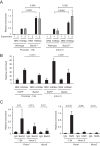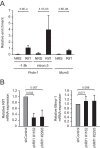Epigenetic Regulation of the Blimp-1 Gene (Prdm1) in B Cells Involves Bach2 and Histone Deacetylase 3
- PMID: 26786103
- PMCID: PMC4813568
- DOI: 10.1074/jbc.M116.713842
Epigenetic Regulation of the Blimp-1 Gene (Prdm1) in B Cells Involves Bach2 and Histone Deacetylase 3
Abstract
B lymphocyte-induced maturation protein 1 (Blimp-1) encoded by Prdm1 is a master regulator of plasma cell differentiation. The transcription factor Bach2 represses Blimp-1 expression in B cells to stall terminal differentiation, by which it supports reactions such as class switch recombination of the antibody genes. We found that histones H3 and H4 around the Prdm1 intron 5 Maf recognition element were acetylated at higher levels in X63/0 plasma cells expressing Blimp-1 than in BAL17 mature B cells lacking its expression. Conversely, methylation of H3-K9 was lower in X63/0 cells than BAL17 cells. Purification of the Bach2 complex in BAL17 cells revealed its interaction with histone deacetylase 3 (HDAC3), nuclear co-repressors NCoR1 and NCoR2, transducin β-like 1X-linked (Tbl1x), and RAP1-interacting factor homolog (Rif1). Chromatin immunoprecipitation confirmed the binding of HDAC3 and Rif1 to the Prdm1 locus. Reduction of HDAC3 or NCoR1 expression by RNA interference in B cells resulted in an increased Prdm1 mRNA expression. Bach2 is suggested to cooperate with HDAC3-containing co-repressor complexes in B cells to regulate the stage-specific expression of Prdm1 by writing epigenetic modifications at the Prdm1 locus.
Keywords: B cells; acetylation; epigenetics; gene regulation; histone; methylation; plasma cells; transcription factor.
© 2016 by The American Society for Biochemistry and Molecular Biology, Inc.
Figures









Similar articles
-
Plasmacytic transcription factor Blimp-1 is repressed by Bach2 in B cells.J Biol Chem. 2006 Dec 15;281(50):38226-34. doi: 10.1074/jbc.M607592200. Epub 2006 Oct 17. J Biol Chem. 2006. PMID: 17046816
-
Histone deacetylase inhibitors upregulate B cell microRNAs that silence AID and Blimp-1 expression for epigenetic modulation of antibody and autoantibody responses.J Immunol. 2014 Dec 15;193(12):5933-50. doi: 10.4049/jimmunol.1401702. Epub 2014 Nov 12. J Immunol. 2014. PMID: 25392531 Free PMC article.
-
Regulation of the plasma cell transcription factor Blimp-1 gene by Bach2 and Bcl6.Int Immunol. 2008 Mar;20(3):453-60. doi: 10.1093/intimm/dxn005. Epub 2008 Feb 5. Int Immunol. 2008. PMID: 18256039
-
Orchestration of plasma cell differentiation by Bach2 and its gene regulatory network.Immunol Rev. 2014 Sep;261(1):116-25. doi: 10.1111/imr.12201. Immunol Rev. 2014. PMID: 25123280 Review.
-
Orchestration of B lymphoid cells and their inner myeloid by Bach.Curr Opin Immunol. 2016 Apr;39:136-42. doi: 10.1016/j.coi.2016.01.012. Epub 2016 Feb 16. Curr Opin Immunol. 2016. PMID: 26894991 Review.
Cited by
-
IL-2 imprints human naive B cell fate towards plasma cell through ERK/ELK1-mediated BACH2 repression.Nat Commun. 2017 Nov 13;8(1):1443. doi: 10.1038/s41467-017-01475-7. Nat Commun. 2017. PMID: 29129929 Free PMC article.
-
Nuclear organisation and replication timing are coupled through RIF1-PP1 interaction.Nat Commun. 2021 May 18;12(1):2910. doi: 10.1038/s41467-021-22899-2. Nat Commun. 2021. PMID: 34006872 Free PMC article.
-
O-GlcNAcylation Signal Mediates Proteasome Inhibitor Resistance in Cancer Cells by Stabilizing NRF1.Mol Cell Biol. 2018 Aug 15;38(17):e00252-18. doi: 10.1128/MCB.00252-18. Print 2018 Sep 1. Mol Cell Biol. 2018. PMID: 29941490 Free PMC article.
-
A cell-based bioluminescence assay reveals dose-dependent and contextual repression of AP-1-driven gene expression by BACH2.Sci Rep. 2020 Nov 3;10(1):18902. doi: 10.1038/s41598-020-75732-z. Sci Rep. 2020. PMID: 33144667 Free PMC article.
-
microRNA-142 is upregulated by tumor necrosis factor-alpha and triggers apoptosis in human gingival epithelial cells by repressing BACH2 expression.Am J Transl Res. 2017 Jan 15;9(1):175-183. eCollection 2017. Am J Transl Res. 2017. PMID: 28123644 Free PMC article.
References
-
- Igarashi K., Ochiai K., Itoh-Nakadai A., and Muto A. (2014) Orchestration of plasma cell differentiation by Bach2 and its gene regulatory network. Immunol. Rev. 261, 116–125 - PubMed
-
- Shaffer A. L., Lin K. I., Kuo T. C., Yu X., Hurt E. M., Rosenwald A., Giltnane J. M., Yang L., Zhao H., Calame K., and Staudt L. M. (2002) Blimp-1 orchestrates plasma cell differentiation by extinguishing the mature B cell gene expression program. Immunity 17, 51–62 - PubMed
-
- Shapiro-Shelef M., Lin K. I., McHeyzer-Williams L. J., Liao J., McHeyzer-Williams M. G., and Calame K. (2003) Blimp-1 is required for the formation of immunoglobulin secreting plasma cells and pre-plasma memory B cells. Immunity 19, 607–620 - PubMed
-
- Sciammas R., and Davis M. M. (2004) Modular nature of Blimp-1 in the regulation of gene expression during B cell maturation. J. Immunol. 172, 5427–5440 - PubMed
Publication types
MeSH terms
Substances
LinkOut - more resources
Full Text Sources
Other Literature Sources
Molecular Biology Databases
Research Materials
Miscellaneous

